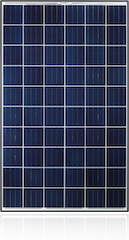Best Solar Panels
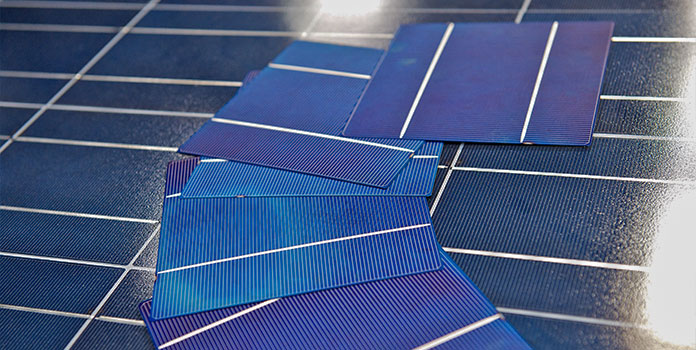
How do you choose the best solar panels for your home?
When thinking about what components make the best solar panels, every homeowner’s situation is different. Finances, location, and personal values all play a role in deciding which is the best solar panel for you.
Some prefer the cheapest solar panel, while others insist their panels must be American-made. Some people live in areas with heavy snow, while others don’t have to worry about bad weather. There’s not a single solar panel that works perfectly in every situation!
Most solar companies offer a handful of different solar panels and they’ll happily discuss your different options with you.
To help out, we’ve found some of the best solar panels for a variety of situations, from bargain options all the way up to premium, ultra-durable panels. To make our list as helpful as possible, we’ve limited our search to residential solar panels with a capacity of around 240 to 320 watts.
This narrows our scope, especially in the lowest price category, as there are a handful of ‘bargain bin’ solar panels that, despite having 60 cells, produce around 220-230 watts due to their low efficiency.
Our Picks for Best Solar Panels
Now that we’ve talked about our whole process, let’s get to the good stuff! To make this as useful as possible, we’ve broken our top picks into categories.
- Best All-Around: Hanwha Q-Cell
- Highest Efficiency: SunPower X Series
- Best Warranty: SunPower
- High Snow Load Strength: Canadian Solar
- American Made: SolarWorld
- Lowest Price: Topoint
Now let’s take a deeper look into each panel! If you want to read up a bit more on what makes a great solar panel, keep reading after our list.
Best All-Around: Hanwha Q-Cell
Efficiency: 17.4% to 19.6%
Warranty: 12 year material; 25 year power (83.6% after 25 years)
Cell Type: Monocrystalline
Hanwha Q-Cell solar panels are the ‘go-to’ solar panels for many solar companies and for good reason. The joint German-South Korean company is the largest solar cell producer in the world. Their panels see excellent efficiency and their warranty covers a couple more years than the average warranty.
Hanwha entered the market fast and is now one of the major global solar panel manufacturers, working in countries around the globe. Hanwha itself is a large South Korean business conglomerate with their hands in a variety of markets, including financial services, hotels, chemicals, and even baseball. The size of their business allows them to source materials cheaply and produce huge volumes of panels, driving down prices.
If you’re looking for great quality at a good price, Hanwha takes the cake.
Highest Efficiency: SunPower X Series
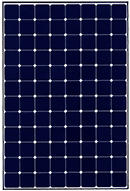 Cost: $$$$ out of $$$$
Cost: $$$$ out of $$$$
Efficiency: 21.1% to 21.5%
Warranty: 25 year material; 25 year power (80% of original performance guaranteed after 25 years)
Cell Type: Monocrystalline
American-made SunPower panels are the most efficient residential solar panels in the world, clocking in at over 21% – much higher than any other panel on the market. This high efficiency though comes at a much higher price. Some estimate that homeowners will spend about twice as much on these panels!
Why pay so much for 3-4% more efficiency? Well, it’s actually more electricity than you’d expect. Doing some math, the Sunpower panels actually produce 10% more electricity than the Hanwha panels above (21.6 / 19.6 = 1.102).
On top of that, Sunpower offers an incredible warranty (see below for more info on this, as Sunpower is on our list twice!) And to round out their awesomeness, Sunpower’s panels are American-made and ultra-high quality, with beefy electrical components that can withstand anything mother nature can throw at them.
As the old saying goes, you get what you pay for, and Sunpower is certainly top of the line. However, their high price means that most homeowners would have a hard time justifying the additional expense.
Best Warranty: SunPower

Cost: $$$$ out of $$$$
Efficiency: 21.1% to 21.5%
Warranty: 25 year material; 25 year power (80% of original performance guaranteed after 25 years)
Cell Type: Monocrystalline
We noted that SunPower has the highest efficiency of any solar panel in the residential market today, but on top of that, they offer the longest warranty in the solar industry.
With a 25 year material warranty, SunPower backs up its technology for a full 15 years longer than most other solar companies’ 10 year warranty.
Sunpower’s warranty is driven by its belief in the longevity of the panel’s components, which include overbuilt electrical connections that can handle repeated contraction and expansion from extreme weather changes as well as generally sturdy panel construction. In fact, the panel itself is even thicker than Canadian Solar’s panel (see below) by a full 2mm!
As mentioned though, you don’t get the best for free and all of this comes with significant cost. Still, if you’re looking for a great warranty, you found it.
High Snow Load Strength: Canadian Solar
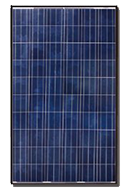 Cost: $$ out of $$$$
Cost: $$ out of $$$$
Efficiency: Up to 16.8%
Warranty: 10 year material; 25 year power (83% after 25 years)
Cell Type: Polycrystalline
At 40mm, Canadian Solar’s panels are about 20% thicker than other manufacturers, so they can withstand harsh environments and heavy snow loads. Because of this strength and fairly low cost, nation-wide solar companies choose Canadian Solar when an installation is located in an area with heavy snow.
Other solar companies, like SunPower above, also produce quite beefy solar panels that can withstand almost anything Mother Nature throws at it, but at a much higher cost. Canadian Solar keeps the price low, providing the most cost-effective option if heavy loads are a concern, but you don’t want to shell out huge bucks for your installation.
American Made: SolarWorld
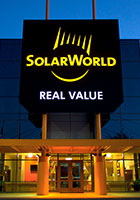 Cost: $$$ out of $$$$
Cost: $$$ out of $$$$
Efficiency: 16.7%
Warranty: 10 year material; 25 year power (86.8% after 25 years)
Cell Type: Monocrystallline
If supporting local business is high on your list, look to SolarWorld, which has been creating solar panels in the US since 1975. While they manufacture across the globe, the majority of solar panels installed in the US are manufactured in their Oregon factory.
According to its website, SolarWorld has spent more than $1.5 billion since 2008 in domestically-sourced equipment and parts and employs hundreds of people in their main US factory in Oregon.
SolarWorld’s flagship monocrystalline Sunmodule panels have decent specs and great warranty, but as with any domestically-built product, prices are higher than their imported counterparts. However, if supporting quality American manufacturing is of upmost importance to you, SolarWorld’s panels definitely make the cut.
Lowest Price: Topoint
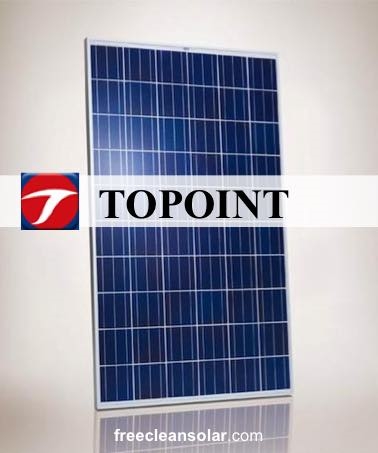 Cost: $ out of $$$$
Cost: $ out of $$$$
Efficiency: 14.75%
Warranty: 10 year material; 25 year power (80% after 25 years)
Cell Type: Polycrystalline
If price is your biggest concern and you have ample roof space, take a look at Topoint’s solar panels. The solar industry is notoriously fluctuating and many solar panel manufacturers and installers have come and gone, so make sure you do your homework before moving forward, as there isn’t much information available on this little-known brand.
That being said, Topoint offer a standard 10 year material and 25 year performance warranty, so that assuages some fears.
The low price comes at the cost of efficiency, as these modules produce about 10% less energy than most other panels on our list. If you have a large roof where space isn’t an issue and working with a little-known company doesn’t bother you, Topoint offers some of the cheapest panels around today.
Other Solar Panels to Consider
Certainly don’t consider our list of the best solar panels as definitive. There are many others out there that also enjoy great prices, good warranties, and high efficiency. Here we highlight just a couple more to get the ball rolling. Even though they didn’t make our list above, they’re still worthwhile to check out.
Trina Solar
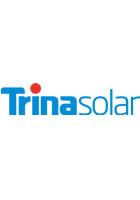
Cost: $$ out of $$$$
Efficiency: Up to 17.4%
Warranty: 10 year material, 25 year power (80.7% after 25 years)
Cell Type: Monocrystalline
Trina Solar is the world’s largest solar panel producer, shipping 5 gigawatts of solar panels in 2016. Their residential ALLMAX panels produce between 270-285 watts and see a max efficiency of 17.4% – inline with others on our list. However, their 10 year product warranty is on the lower side of the spectrum.
Trina Solar’s been around over 20 years – since 1997 – and they’ve earned quite a reputation since then for making reliable and cost-effective products. They’re a great option for your solar installation, and you’d have years of faithful service out of them.
Yingli Solar
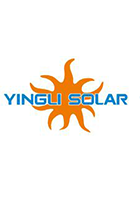
Cost: $$ out of $$$$
Efficiency: Up to 16.8%
Warranty: 10 year material, 25 year power (80.7% after 25 years)
Yingli Solar clocks in at #9 in the list of the world’s 10 biggest solar panel manufacturers. They produce panels for both residential and commercial installations, and their YGE 60 cell Series 2 panels are quite popular. As you can see above, their efficiency is a tad lower than others listed here, but their warranty boasts pretty much the exact same specs as the Trina Solar panels above.
Yingli is a trusted name in the solar industry and you’d be in good hands with their panels on your roof.
What Makes a Good Solar Panel?
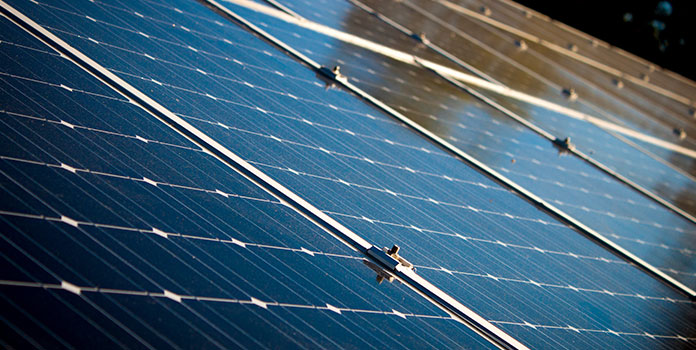
Finding the best solar panel means assessing each of these factors and choosing which one makes the most sense for you. Let’s take a look at what important factors you should consider when choosing solar panels.
Balance Efficiency and Cost
When assessing solar panels, you want to make sure you’re getting the most bang for your buck.
There’s actually a very simple way to ensure you get the most cost-effective option. You just need to look at each solar panel’s $/watt cost. This data point takes into account two different – but crucial – considerations: cost and panel wattage (ie size).
Simply looking at cost alone isn’t that useful, as smaller panels typically cost less, and vice versa. On the other hand, just looking at wattage means you’re ignoring cost. Therefore, using $/watt allows you to compare solar panels of many different sizes and prices with useful results.
Let’s look at an example:
- Panel A is rated at 275 watts and costs $165.
- Panel B is rated at 320 watts and costs $245.
Which one is a better deal? Let’s look at the $/watt cost:
- Panel A costs $0.60 per watt (165/275=0.60)
- Panel B costs $0.76 per watt (245/320=0.76)
So, all else being equal, Panel A is a much better deal, even though you’ll need more panels to produce all the electricity you need, since it produces less electricity. Of course, in the real word, you need to balance this data point ($/watt) with warranty, company reputation, and other factors.
It might be worthwhile to bite the bullet on a higher $/watt if the manufacturer has an incredible reputation or a longer warranty than others. Even if you spend more upfront, with a longer warranty you could avoid expensive replacement/repair costs down the line.
Wattage/Efficiency
We already touched on wattage above, but let’s dig into this a little bit more. Obviously, the higher a solar panel’s wattage, the more electricity the solar panel will produce. Since most solar panels for residential use are about the same physical dimensions (roughly 3 feet X 5 feet), higher wattage usually entails higher efficiency (meaning the solar cells are more efficient at converting incoming sunlight into electricity).
Most solar panels installed on our roofs today are around 16% to 18% efficient and produce about 270 watts, though that number can jump as high as 22% (and a massive 345 watts) for premium panels.
You might think that higher efficiency panels make more sense – after all, higher efficiency means you need less panels right? While that is true, typically the higher efficiency and resulting lower panel count doesn’t justify the higher cost. That’s why comparing $/watt is so important!
Warranty
After $/watt cost, warranty is probably the 2nd most important factor when deciding on your solar installation. A panel manufacturer that truly believes in their product – that it is durable and well-made – will back up that belief with a great warranty.
Solar panels actually come with two different warranties:
- Product Warranty – This is the same as any other product warranty, promising that the piece of equipment will perform as expected, without breaking, for a certain amount of time. For solar panels, product warranties typically last around 12 years, though for the best solar panels that number can jump up to 25 years.
- Production Guarantee – Panel manufacturers also provide guarantees that the solar panel will hit certain production targets throughout its life, in essence promising the solar panel will continue to produce a good amount of electricity over its long life. These guarantees are crucial, as a solar panel’s efficiency decreases as its left out on the roof in the sun, cold, and rain year after year. Typically, companies will ensure that solar panels will produce around 80% to 87% of the nameplate rating (ie, the advertised wattage) in the 20th year of installation.
When choosing your solar panels, you need to take the manufacturer’s warranty into account, as well as if they’re quick to honor that warranty. If they’re easy to deal with, you’ll have a much better experience if something goes wrong 12 years down the line.
Reputation
With so many solar panel manufacturers out there, a company’s reputation should play an important role in your decision to install solar. If you look on Amazon, you’ll see panels from numerous ‘off brand’ manufacturers that only sell on Amazon and have no online presence other than their Amazon listings. While of course, there are reputable products on Amazon as well, it’s probably best to avoid these.
Mega-corporations like Sony, Panasonic, and LG also make panels, so there’s a huge variety in panel manufacturers and their size, reputation, and trustworthiness.
Most of the biggest solar panel manufacturers in the world focus exclusively on manufacturing solar panels and these companies are typically able to offer the most cost-effective solar panels, balancing price, efficiency, and warranty.
Most, if not all, solar installers in the US use panels from one of the manufacturers in the list above, so for the most part you don’t need to be too worried about your panel manufacturer’s reputation. If your installer is recommending a certain panel, they’ve probably already done the research for you.
If you’re choosing your own solar panels, the rules are pretty similar to any large purchase: Do your research and don’t pick a sketchy company. Here’s some tips:
- If they don’t have a website: PASS
- If their product warranties are very short (less than 10 years): PASS
- If you can’t find any information and/or reviews from 3rd party sites (Like Understand Solar!): PASS
- If they’re only on Amazon: PASS (If you’re only installing a small off-grid system on your RV or shed, you could probably bend this rule a little bit, but we’re discussing large roof-top installations here.)
Solar installers are your best friend when assessing manufacturer reputations, as they’ll often have the inside scoop on solar panel reliability and quality. Your best course of action is to call up a few installers in your area and get their opinion. They can tell you which panels work best in your area and any special considerations, like utility requirements for solar equipment, you need to know.
Temperature Coefficient
We hesitated adding this to our list, but ultimately found it useful for those who really want to dig in to what makes a great solar panel. Other articles have cited temperature coeffcient as an important consideration when choosing solar panels, but honestly this is certainly NOT something that should ultimately affect your decision. At most, it’s a technical factor to be aware of and most solar panels have very similar temperature coefficients.
But first, what is temperature coefficient? It’s a strange name for a very simple concept.
All solar panels lose efficiency as they get hotter and hotter. The rate at which the solar panels lose efficiency is the temperature coefficient. The higher the coefficient, the faster they lose efficiency.
The mid-priced Jinko Solar Eagle 60, for example, sees a temperature coefficient of -0.40% for each degree above 25C (77F) of ambient temperature. Just half a percent doesn’t sound like much, but it adds up quickly. And as you can imagine, the temperature on your dark-colored roof – baking in the sun – can climb quickly!
- With a temperature coefficient of -0.40%/ °C, a 270 watt Jinko Eagle panel at 40°C (104°F, easily reachable on a hot day) will produce 254 watts – a 6% drop! (Formula: 270 watts – ((40°-25°)*0.40%*270 watts)).
Now let’s say our temperature coefficient is just -0.29%/°C, like the premium Sunpower panels we linked to above. It doesn’t seem that much lower than Jinko’s rate, but let’s plug this new temp coefficient into our example:
- A temperature coefficient of -0.29/°C on a 270 watt panel (which Sunpower doesn’t make, but we’ll keep the wattage the same for our example to make the results easier to compare) will produce 258 watts.
You can see that, at 104°F, wattage drops just a few points. While temperature coefficient is certainly important, the best solar panels have such similar coefficients that, unless you live in an extremely hot climate where the sun beats down for most of the year, it’s not really an issue. While a coefficient close to zero would be ideal of course, that’s simply not possible!
In the end, take a look at the temp coefficient just to make sure it’s not eye-catchingly high, then don’t worry about it – it’s just the way things work (for now at least!)
Mono vs Polycrystalline Panels: What Should You Choose?
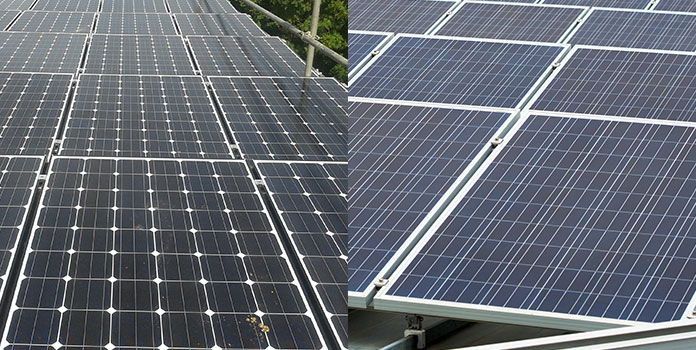
You’ve probably heard installers or companies claiming that the best solar panels are only monocrystalline while others claim only polycrystalline panels are worthwhile. In reality though, it doesn’t really matter all that much. Let’s take a quick look now to differentiate between the two.
Monocrystalline Silicon
Until recently, monocrystalline was the only option if you wanted premium, high-efficiency panels and indeed, back 20 years ago mono panels were the most popular solar panel technology on the market.
Even today mono panels are the most efficient in the world, with Sunpower’s monocrystalline X-Series enjoying the world record for efficiency among residential solar panels, at 22.8% efficiency.
Manufacturers produced this higher efficiency by creating extremely pure silicon through a very laborious process. And with this complicated process naturally comes higher prices.
Looking for a solution to the cost issue, panel manufacturers dove into cheaper polycrystalline panels, hoping to bring them up to mono-level efficiency.
Polycrystalline Silicon
In regards to popularity, polycrystalline panels are now king. They can be seen across the country on thousands of rooftops. While once relegated to 2nd rate status due to their lower efficiency when compared to monocrystalline panels, thanks to dedicated, ongoing R&D from panel manufacturers, poly efficiency is now on-par with all but the highest efficiency mono panels.
Manufacturing polycrystalline silicon is much less intensive than monocrystalline panels and costs therefore are typically cheaper. Similar efficiency and less expensive than mono panels? That’s a win-win, and the reason why poly panels have overtaken monocrystalline panels in popularity.
So which should you choose? Honestly, it really doesn’t matter, as they are both excellent at converting sunlight to electricity. Instead of fretting about cell type, focus instead on cost (in $/watt, of course) and warranty.
Tip: If you really want to dig in, take a look at our articles The Different Types of Solar Panels as well as Monocrystalline Solar Panels vs Polycrystalline Solar Panels for a more detailed look.
Tips for Choosing the Best Solar Panels
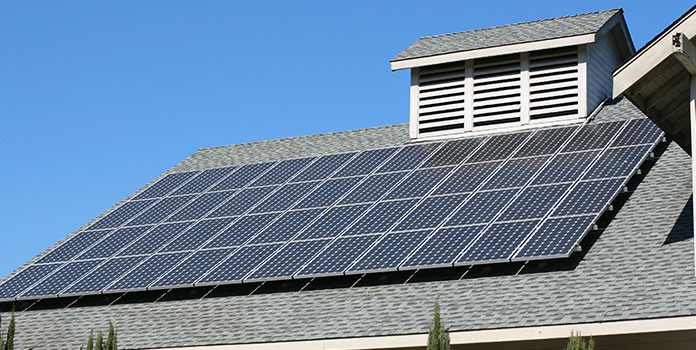
Here’s a few tips to keep in mind before deciding which solar panels to buy:
Proven Track Record
Choose a reputable company with a proven track record. You don’t want to spend thousands of dollars on solar panels, then be stuck with 30 unwarrantied solar panels when the company goes out of business 10 years later.
The solar industry is notoriously up and down and installers as well as manufacturers can and do go out of business, so be sure to do your homework before moving forward with a particular company.
Country of Origin Doesn’t Affect Quality
Country of origin plays little part in the quality of solar panels. Some homeowners in the US are adamant about installing only US-manufactured solar panels, but these panels add quite a bit to the total installation cost and solar panels coming out of reputable East Asian countries can be high quality and backed by long-term warranties.
Seek Advice from Local Installers
Before choosing what panels to install, seek the advice of local installers, as they often have experience with numerous different solar panels and can give you tips or advice on choosing the best solar panels to meet your needs. They might even install an amazing solar panel that you’ve never even heard of and isn’t on our list!
The Best Solar Panel Is the One that Meets Your Needs
Again, it’s hard to talk about the best solar panel out there, as all our needs are different:
- Best All-Around: Hanwha Q-Cell
- Highest Efficiency: SunPower X Series
- Best Warranty: SunPower
- High Snow Load Strength: Canadian Solar
- American Made: SolarWorld
- Lowest Price: Topoint
Take some time to figure out which one makes the most sense for you. Speaking with an installer or two can help you narrow down your search for the best solar panel and give you valuable information on what panels work best in your local area, so take advantage of these great resources as well!
Image Credits: CC via Flickr 1, 3a, 3b, 4, Public Domain via Pexels 2, Public Domain via Wikimedia – 5, Courtesy Yingli via Wikimedia 6, Courtesy of Sunpower, SolarWorld, All others Courtesy Amazon

